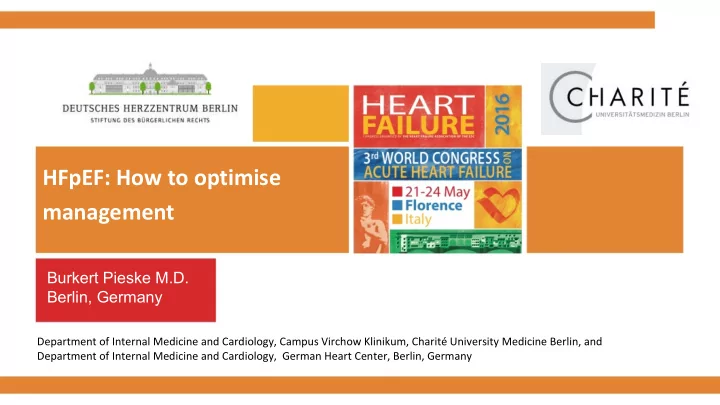

HFpEF: How to optimise management Burkert Pieske M.D. Berlin, Germany Department of Internal Medicine and Cardiology, Campus Virchow Klinikum, Charité University Medicine Berlin, and Department of Internal Medicine and Cardiology, German Heart Center, Berlin, Germany
Disclosures Speaker Bureau, Consultancy, Advisory Board/Committee for: Bayer Healthcare, MSD, Novartis, Astra-Zeneca, Stealth Peptides, Servier, Daiichi- Sankyo, Biotronic, Abbott Vascular
ESC 2016: How to optimize management 1. Identify the patient – Diagnosis 2. Classify the patient – Etiology and Stratification 3. General principles of management 4. Specific therapeutic approaches
ESC 2016: Typical demographics and co-morbidities associated with HFpEF – Who are these patients?
ESC HF GL 2016: Definition of heart failure with preserved (HFpEF), mid-range (HFmrEF) and reduced ejection fraction (HFrEF) ESC 2016: „Signs and symptoms of HF are often non-specific and do not discriminate well between HF and other clinical conditions“
Diagnostic algorithm for HF of non-acute onset
ESC 2016 Key Diagnostic HFpEF Criteria „Preserved“ EF ≥ 50% LAVI >34 mL/m 2 or Structural alterations: LVMI ≥ 115 (males) / ≥95 (females) mg/m 2 Functional alterations: E/é ≥ 13 é (mean septal and lateral) <9 cm/s NTproBNP: >125 pg/mL or (SR; increase with Afib!) BNP: >35 pg/mL
ESC 2016: Normal & abnormal echocardiographic indices of diastolic function according to age categories, differentiated for gender
ESC 2016 Additional Diagnostic HFpEF Criteria Longitudinal strain Tricuspid regurgitation velocity Diastolic stress test: Semi-supine exercise echocrdiography Invasive hemodynamics at rest (PCWP≥15 mmHg) and with exercise
Exercise echocardiography (Diastolic stress test)
ESC 2016: How to optimize management 1. Identify the patient – Diagnosis 2. Classify the patient – Etiology and Stratification 3. General principles of management 4. Specific therapeutic approaches
Senni & Pieske, Eur Heart J 2014
Prospective cross-sectional study, symptomatic HFpEF including LVH (LVEDWT ≥12mm) 99m Tc-3,3-diphosphono-1,2-propanodi-carboxylic acid scintigraphy ( 99m Tc-DPD) Genetic analysis for mutations in the TTR gene
Wild-type transthyretrin amyloidosis: Scintigraphy 99m Tc-3,3-diphosphono-1,2-propanodi-carboxylic acid scintigraphy (severe 99m Tc-DPD cardiac uptake) Gonzáles-López E et al. Eur Herat J 2015; 36:2585-2594
Summary: Diagnosis of HFpEF • 120 HFpEF patients included • 16 patients (13.3%) with moderate-severe 99m Tc-DPD cardiac uptake • No mutations found on genetic testing • EMB in 4 patients demonstrated ATTR WT in all cases
ESC 2016: Diagnostic tests for specific causes of HFpEF
ESC 2016: How to optimize management 1. Identify the patient – Diagnosis 2. Classify the patient – Etiology and Stratification 3. General principles of management 4. Specific therapeutic approaches
ESC 2016: How to optimize management • Only slightly fewer patients with HFpEF appear to receive diuretics, beta-blockers, MRAs, ACEI, or ARBs - comorbidities or extrapolation? • Screen and treat cardiovascular comorbidities – Arterial hypertension, CAD, pulmonary hypertension • Screen and treat non-cardiovascular comorbidities (diabetes, CKD, anaemia, iron deficiency, COPD, obesity) • Hospitalisations/death in HFpEF more likely to be non-cardiovascular than in HFrEF
Importance of co-morbidities in patients with HF
Recommendations for treatment of patients with HFpEF and HFmrEF
ESC 2016: Management of specific comorbidities
Treatments not recommended for co-morbidities in patients with HF
General principles of management 1.Optimal control of risk factors and comorbidities? BP<130/80 mmHg (preferentially by RAS blocker) HBA1c < 6.5 mg% (Metformin, SGL2-Inhibitor; avoid insulin wherever possible) Statin therapy in indicated Correct myocardial ischemia Treat pulmonary disease 2.Inadequate hypertensive blood pressure response to exercise? Stress test – optimize BP response 3.Heart rate response to exercise? Tachycardic – control inadequate increases in heart rate Chronotropic incompetence? Reduce bradycardic agents, consider PM
General principles of management 4.Atrial fibrillation? Restore SR if possible Anticoagulation as indicated 5.Signs of hypervolemia or pulmonary congestion? Loop diuretics Restrict volume and salt intake 6.Physical inactivity/overweight? Implement physical activity/exercise training programs Initate weight loss preferably by structured programs
Targeting therapies to the HFpEF phenotype Senni M & Pieske B, Eur Heart J 2014
ESC 2016: How to optimize management 1. Identify the patient – Diagnosis 2. Classify the patient – Etiology and Stratification 3. General principles of management 4. Specific therapeutic approaches
ESC 2016: Specific HFpEF therapies? ESC 2016: „No treatment has been shown, convincingly, to reduce morbiditiy and mortality in patients with HFpEF or HFmrEF“
Mitter SS and Shah SJ., Curr Atheroscler Rep, 2015 Nov, 17(11):64
TOPCAT: Heart Failure Hospitalizations TOPCAT: Heart Failure Hospitalizations Total HF Hosp Spiro : 394 Placebo: 475 245/1723 (14.2%) P<0.01* Placebo 206/1722 (12.0%) Spironolactone HR = 0.83 (0.69 – 0.99) p=0.042 *poisson regression
Suggested algorithm for Sprinolactone in HFpEF Mitter SS and Shah SJ., Curr Atheroscler Rep, 2015 Nov, 17(11):64
Generation of an inter-atrial shunt Hasenfuss G et al., J Card Fail, 2015 Jul, 21(7):594-600
Hasenfuß Lancet 2016
Kitzman DW et al., JAMA, 2016 Jan 5, 315(1):36-46
Ex-DHF pilot: Exercise training in elderly HFpEF Primary Endpoint: peak VO2 Maximum Workload HFpEF=heart failure with preserved ejection fraction Edelmann F et al., JACC 2011;58:1780–91
Summary: ESC 2016 – Management of HFpEF • New definitions: HFpEF vs. HFmrEF, more specific imaging cutoffs • Exercise stress test (echo, invasive, mentioned for first time) • Mandates for etiological workup to target therapies • Mandates for minute assessment and therapy of comorbidities • Give general management recommendations, including loop diuretics • State that no specific therapies are available yet
Recommend
More recommend